An Entire Glacial GeologyThe science that deals with the dynamics and physical history of the earth, the rocks of which it is composed, and the physical, chemical, and biological changes that the earth has undergone or is undergoing. Course in One Trip
This trip has been like an advanced and condensed version of a glacial geology and geomorphology course. I have studied many of the ice features and glacial landforms in my undergraduate and graduate career, and I even teach about them myself in my courses. However, actually seeing and touching these things I have only read about in textbooks was an incredible experience.
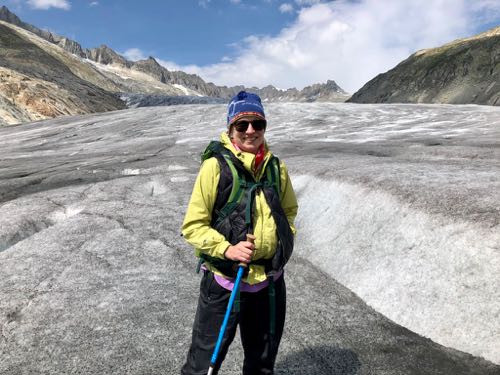
I have already discussed many of the landforms and features glaciers make as they carve their way across land and through valleys in many of my journals. I can’t possibly go over all of the many different types of glacial landforms here, but as my expedition wraps up, I wanted to take some time to explain a few additional features I have come across during my time in the Swiss Alps.
Probably the most common and well-known feature of a glacier is the crevasse. A crevasse is a deep crack or fracture that is found in an ice sheet or glacier. These cracks are formed when shear stress acts on the ice causing it to split. Crevasses can be small, or reach up to several hundred meters long and 100 meters deep.
We could see crevasses on many of the glaciers, but here you can see many in the background and foreground of Rhône GlacierA mass of ice that persists for many years and notably deforms and flows under the influence of gravity..
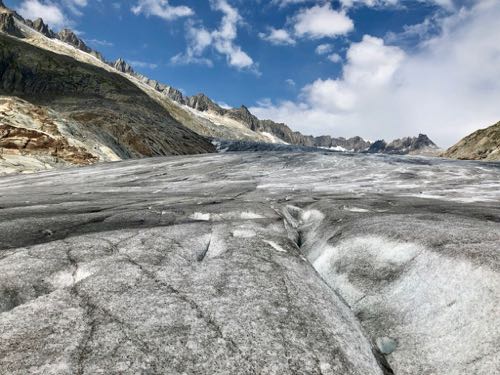
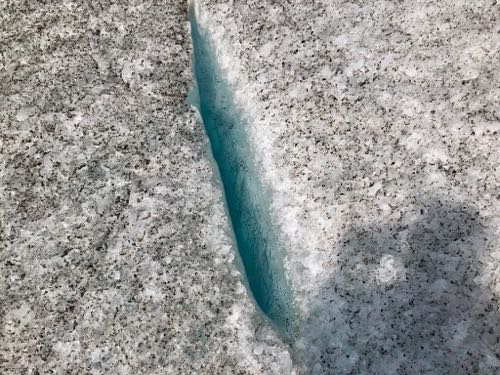
The surface of the ice was also covered with many moulins. A moulin is a vertical hole that connects the surface of the glacier or ice sheet to the in glacial conduits located in the interior of the glacier. The conduits are basically the internal plumbing system of the glacier that allows water to travel through the ice.
Some of the moulins had rivulets of water flowing down into them and into the glacier, while others were just holes leading down into the glacier. At the latter we did not observe water actively flowing into them, but we could hear water flowing underneath the glacier at some depth.
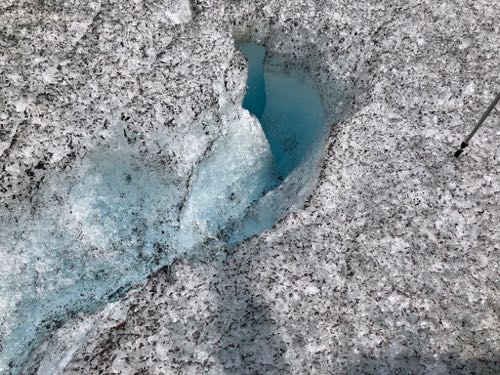
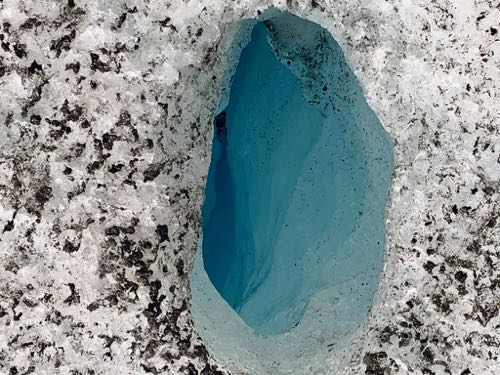
At Rhône GlacierA mass of ice that persists for many years and notably deforms and flows under the influence of gravity. we saw a proglacial lake, which is a lake that has been dammed by some part of the moraine or the ice itself. In the case of Rhône GlacierA mass of ice that persists for many years and notably deforms and flows under the influence of gravity., the lake is dammed on the backside by the glacier. Floating in the lake you could also see a few large icebergs that had calved off of the glacier. When this glacier melts, the lake left behind in the depression formed through glacial erosion will be called a tarn.
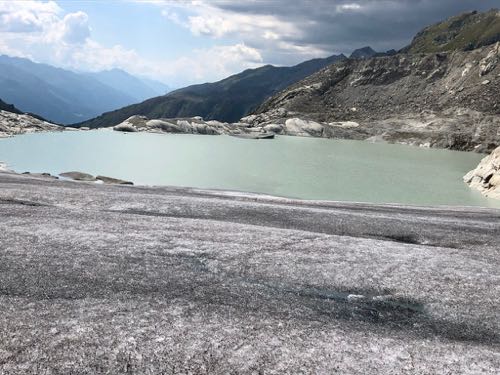
Looking down on Aletsch GlacierA mass of ice that persists for many years and notably deforms and flows under the influence of gravity. from high above on the mountaintop, we could spot many other glacial features. One of these features was a supraglacial lake. The lakes are formed when melt water pools on top of the surface of the ice. They can vary in size and are often ephemeral. This means that they are not permanent and can last months to years. However, they can often drain catastrophically in a matter of hours.
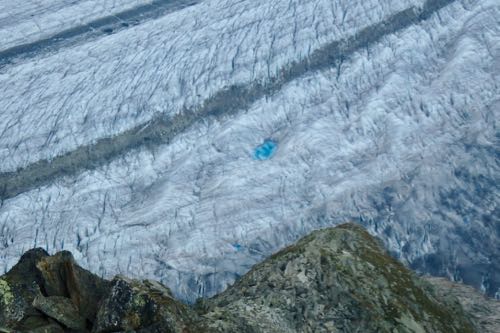
And finally, I want to show you the textbook perfect examples of the lateral and medial moraines at Aletsch GlacierA mass of ice that persists for many years and notably deforms and flows under the influence of gravity.. As I have explained in previous journals, a moraine is a pile of rocks and sediment that is carried along by the movement of the ice. They can form at the sides (i.e. lateral moraines) or front/end of the glacier (i.e. terminal moraines), and when two glaciers flow down the mountain and meet to flow together into way glacier, they form medial moraines. A medial moraine is when the lateral moraines on the outer edge of each glacier join and make a moraine down the center of the newly joined, larger glacier. You can see these as the dark lines running down the center of the glacier in the picture below.
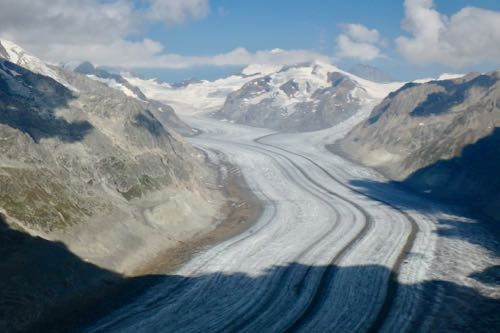
And there you have it! All of you should be experts at glacial terminology now. ;)
Because I know you are all dying to know what the underside of a glacier looks like, I made this short video for you.
PolarTREC Poppy
When in Switzerland, you have to indulge in some of the local foods. We all had some rather tasty dinners at some nearby Swiss restaurants. Here Poppy samples fondue, wiener schnitzel, and apple strudel. Yum!
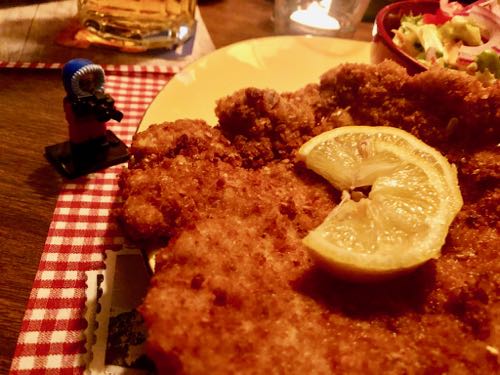
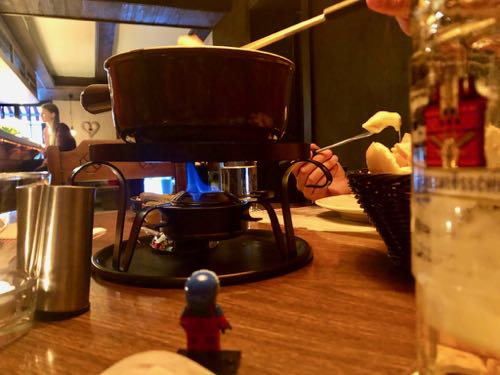
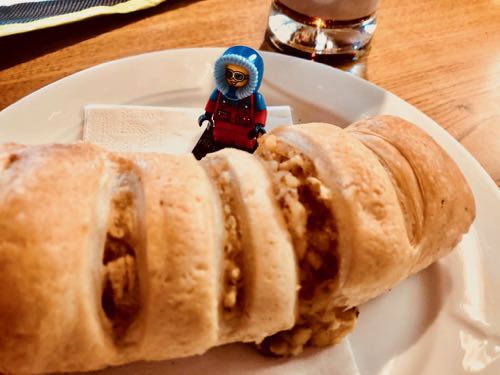
Daily Haiku
Trip nearly at end
Farewell mountain peaks, Until
I meet you again


Comments